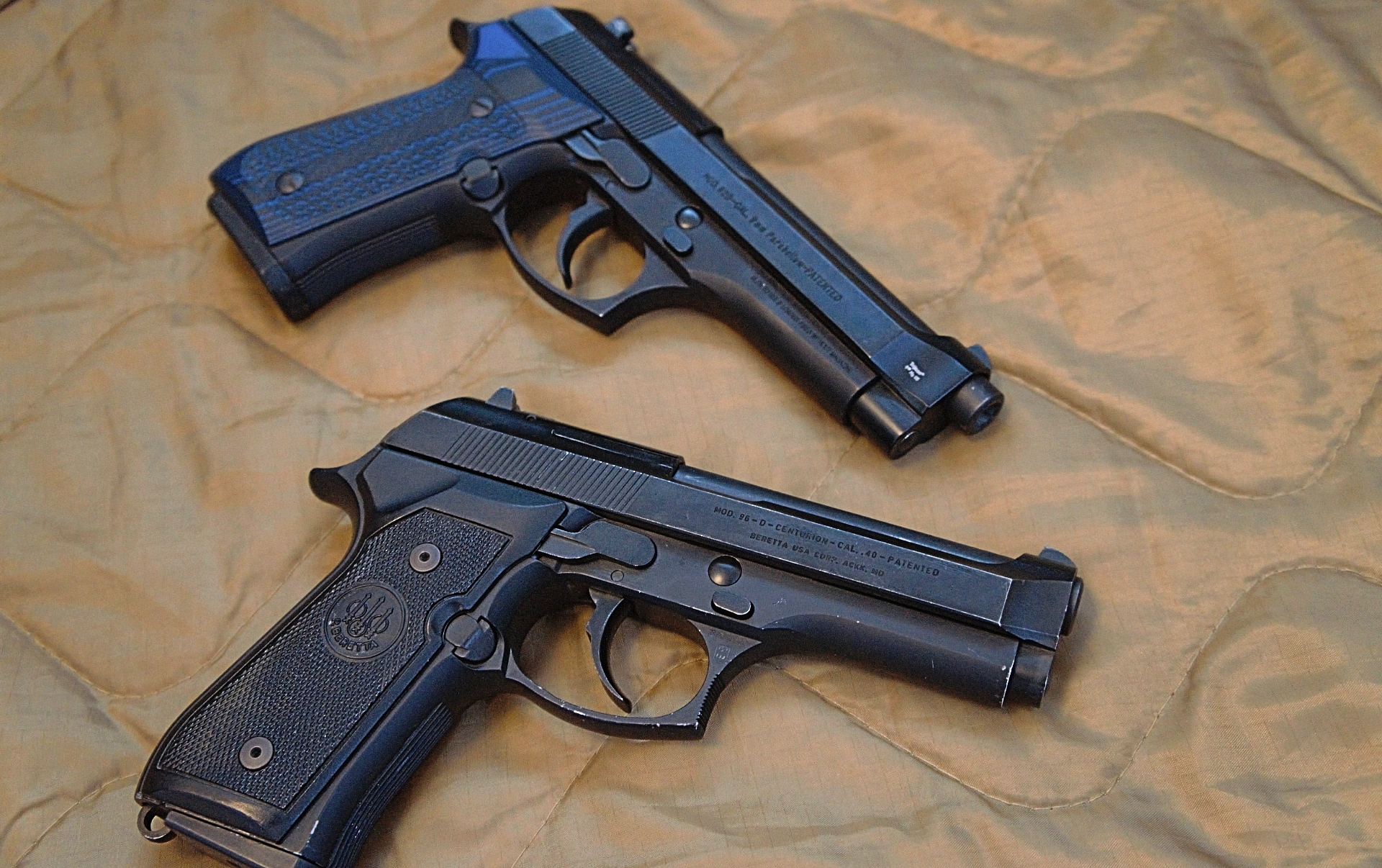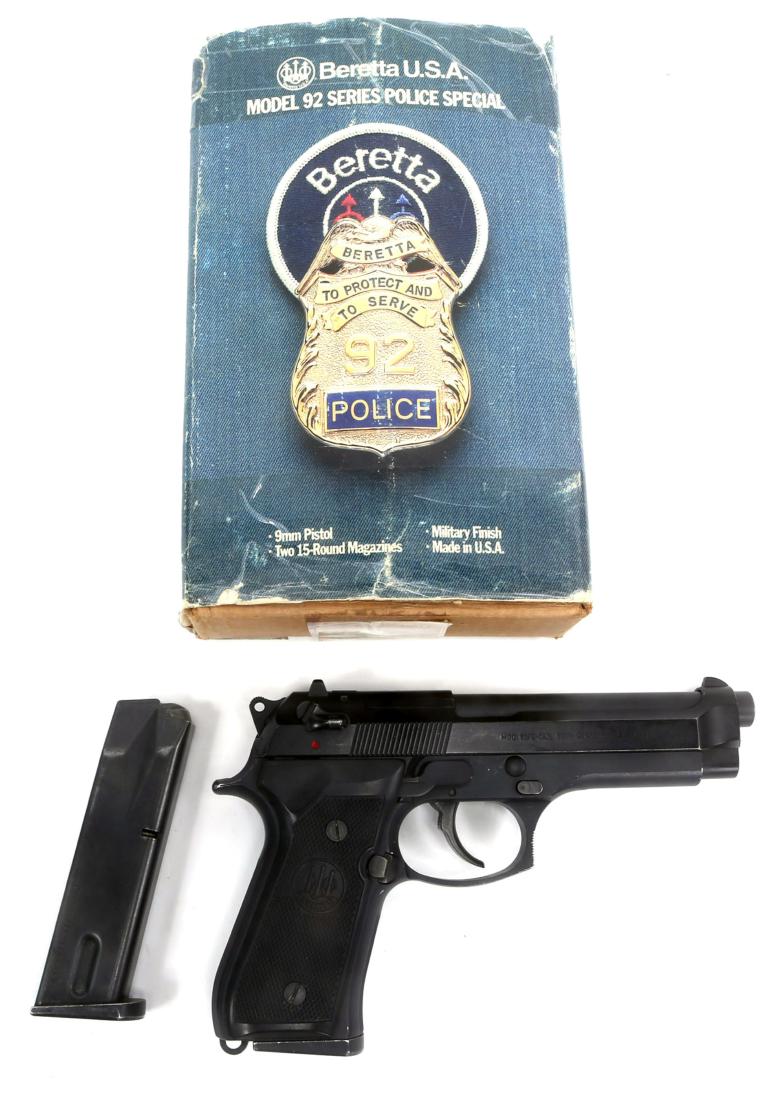Beretta Police Pistol - The Beretta 92 (also Beretta 96, Beretta 98) is a semi-automatic pistol designed by Beretta of Italy. The Beretta 92 was designed in 1975 and went into production in 1976. Many variations in many different calibers are still in use today.
The US Army replaced the .45 ACP M1911A1 pistol in 1985 with the Beretta 92FS, designated "M9".
Beretta Police Pistol

The Beretta 92 pistol was modified from earlier Beretta models, particularly the M1923 and M1951. While the slide design comes from the M1923, the Walther P38 alloy frame and bolt-action barrel were first used in the M1951. The grip angle and front sight combined with the slide were common to earlier Beretta pistols. Perhaps the two most significant design advances of the Model 92 first appeared on its predecessor, the 1974 Model 84 in .380 caliber. These improvements included a magazine that featured live streaming; that is, there was no feed ramp between the magazine and the chamber (a Beretta innovation in pistols). Additionally, the magazine was a "double stack" design, a feature first introduced in the 1935 Browning Hi-Power.
Evolution Of The Beretta 92
Experienced firearms designers Carlo Beretta, Giuseppe Mazzetti and Vittorio Valle contributed to the final design in 1975.
Production began in May 1976 and was produced in February 1983. About 7,000 were of the first "step-slide" design, and 45,000 were of the second "straight slide" design.
To meet certain legislative requirements, Beretta replaced the frame-mounted manual safety with a sliding safety and release lever for the Beretta 92. As a result, the 92S was merged with many Italian legal and military units. The magazine release button is located at the bottom of the grip, as is customary in Europe. This model was produced in 1978-1982.
Originally called the 92S-1, the 92SB was specifically designed for (and won) USAF trials, and the officially approved model name was the 92SB. Added features include a firing pin lock (hence the added "B" to the name), ambidextrous safety lever, 3-point sights, and trigger shift from bottom of trigger to bottom of trigger . . Relocation of the later magazine release button meant that later magazines were not necessarily usable, unless the earlier models (92 and 92S) were notched in both areas.
Beretta Model 92fs Police Special Semi Automatic Pistol
A compact version known as the 92SB Compact with a shorter barrel, slide and 13-round magazine capacity was produced from 1981 to 1991.
A gold-plated, diamond-encrusted Beretta 92F 9mm parabellum pistol was seized from Joaquín "El Chapo" Guzman's safe. (Source: Drug Force Administration Museum and Visitors Center)
In 1984, Beretta created a slightly modified version of the 92SB, the 92SB-F (with the addition of an "F" for the US federal government test), with the following changes.

A modified version of the 92F was used by the French military as the PAMAS G1 with only the deployment lever. Because these pistol slides contain tellurium and the steel is brittle, they only have a life of about 6,000 rounds.
Beretta 92fs 4.5mm, .177 Cal. Co2 Pellet Air Pistol In India By Airgunkart
The 92FS has a large hammer pin that fits into a groove in the bottom of the slide. The main purpose is to stop the slide from returning from the frame to the rear in case of breakage. This was in response to reports of defective slides during US military tests.
The 92FS also came in the 92FS Cturion model, with the shorter barrel and slide of the 92 Compact on the full-size 92FS frame.
The slide design of the Beretta 92 allows a smooth feed and ejection of ammunition and an ease of removing obstructions. Hard chrome barrel height reduces barrel wear and protects against corrosion. The design of the falling block block provides good accuracy and workability with the suppressor due to the movement of the barrel line. This is in contrast to the complex barrel travel designed by Browning. The magazine release button can be rotated with a simple field tool. Reversing the magazine release facilitates left-handed operation.
In addition to corrosion resistance, the use of polymers to reduce the weight and cost of guns has become increasingly popular. In the early 2000s, Beretta began replacing some parts with polymers and polymer-coated metals. Polymer parts include the recoil spring guide rod (now also beveled), magazine floor plate, magazine follower, and mainspring cap/strap. Polymer coated metal components include the left side safety lever, trigger, and magazine release button.
Stolen Compton Police Handguns Still Missing
To comply with laws that limit magazines to more than 10 rounds in some places, Beretta now produces fewer than the factory standard 15 round magazines. These magazines can be used in existing firearms with a heavier crimp (deeper notch in the side) while reducing clearance while maintaining the same external dimensions. Beretta also produces a 15-round "Sand Resistant" magazine and a 17-round magazine included in the A1 model to address the issue with contracted magazines. Both magazines work in earlier 92 series and M9 style pistols.
Italian magazine maker Mec-Gar now produces blued, nickel-plated 18-round magazines that are fully compatible with Series 92 magazines. Mec-Gar also makes a blued 20-round extended magazine that protrudes 3⁄4 inch (19 mm) under the frame. These magazines provide users in unrestricted states with larger capacity magazines.
The Vertec is a version of the 92 series with a revised backstrap, straight, portable sight, 1-slot accessory rail, flared magwell, and 4.7-inch barrel.

The 90two is the 9mm/.40 version of the 92 series, with a thicker slide and revised frame to accommodate an additional rail, a full dome front sight, and .40 S&W pressure. Other added features include a recoil spring, internal recoil buffer, user-replaceable monogrips and a 17-round magazine.
The Army's Old Beretta M9: Just How Good Is It?
92 FS Ctnial limited edition (500 pieces) commemorating the approval of Beretta's first semi-automatic pistol, the Model 1915, by the Italian Army. This Ctnial 92 features a frame mounted manual safety and single action mechanism only. A Beretta medallion on each wood grip features the anniversary date in Roman numerals and is engraved on both sides of the steel slide. The gun is packed in M2A1 cartridges with the Ctnial logo.
The M9A1 was adopted by the USMC in 2006. It adds a 1-slot Picatinny rail, more aggressive front and rear straps, and a well-angled magazine for easier reloading of the weapon. The M9A1 pistol is available with physical vapor deposition (PVD) coated magazines designed to better withstand the sandy environments of Iraq and Afghanistan.
The M9A3 (the M9A2 concept never went into production) was developed in 2015 as a test response to a modular gun system for the US Army. The main upgrades to the M9A3 were a 3-slot Picatinny rail, a thinner vertical grip, and a removable wraparound stock that was interchangeable between the Vertec model and the "old" M9 model.
Fully detachable tritium night sights and universal slide allow the pistol to be converted from decoy safety to decoy only. The end of the barrel is pre-jointed for ease of adding suppressors.
The Lost Boys Of The Wondernine Years
Beretta/Wilson 92G Brigadier Combat, a joint effort between Wilson Combat and Beretta. Features a heavy Brigade slide, stainless match barrel, single-function ambi-decock and sophisticated action.
These pistols differ from the standard brigade in having a 1913 military standard picatinny rail, all steel controls (as opposed to polymer coated steel), platform only features (G style), 4.7 crown barrels inch, and grooved steels. guides Slim profile G-10 grill, rounded trigger guard, lightweight hammer spring used in the "D" model, Elite II hammer, and its own unique serial number prefixed with "WC" among other features.
The Elite LTT was introduced by Beretta in 2018 in collaboration with firearms instructor Ernest Langdon. The LTT uses a front slot Vertec slide on a modified M9A1 frame and carries a Langdon Tactical G10 grip. The gun features a G-Model splitter, dovetail front sight, steel trigger, guide grip, upgraded spring, and a 4.7 inch stainless reticle with target crown, just to name a few. functions.

The 92x was introduced in 2019 as an update of the 92 series and standardization of the Vertec platform. Like the M9A3, it has a 3-slot Picatinny rail, a slim vertical grip, a removable wraparound grip that can be exchanged between the Vertec model and the "old" M9 model, a fully detachable sight (High Visibility Orange Dot) , is a universal outlet. the slide converts the gun from bait safety to bait only mode. Unlike the M9A3, the barrel is not threaded. The 92x series is available in compact, compact and full-size versions.
Walther P5 Review: A Leaner, Sharper, German Er Beretta 92 — Hipster Tactical ™
The 92x Performance was introduced in 2019 with the 92x as a competition pistol. Like the 92x, it has a 3-slot Picatinny rail, a slim vertical grip, and a removable wraparound grip that can be swapped out for Vertek and "old" M9 style sights. The 92x Performance features a red fiber optic front sight, an adjustable rear sight, and front and rear slides.
Beretta m9, beretta trap, beretta discount, beretta, beretta menu, beretta 92fs police, beretta pink, beretta salami, beretta tools, beretta holster, beretta new, beretta tv
0 Comments